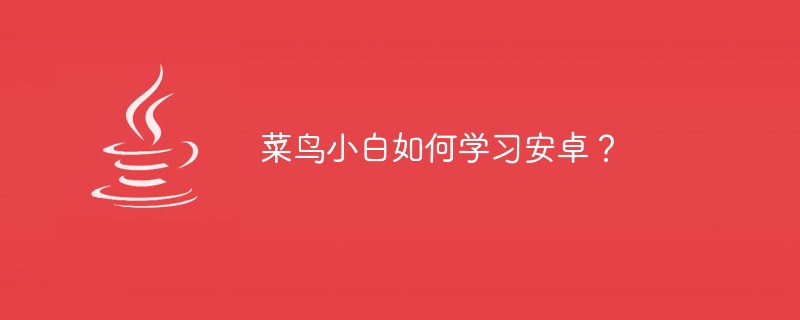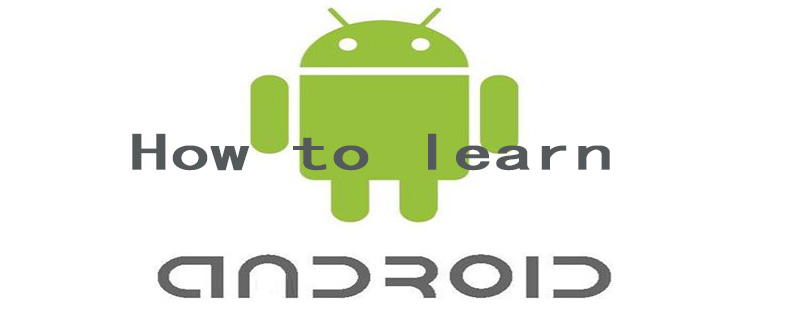
How to learn Android: 1. Learn the basics of Java well; 2. Be familiar with the Android development process; 3. Learn about open source projects and practice frequently; 4. Solve problems independently; 5. Do more practical development, etc.

I have summarized the following points on how to learn Android well: learn the basics of Java well, be familiar with the Android development process, learn about open source projects and practice frequently, and solve problems independently , Carry out more practical development, strengthen your beliefs and persevere. With the rapid development of the Internet and the increase in mobile devices year by year, the popularity of the Android system market is only increasing. The demand for Android development talents by various enterprises is also rising steadily, but it does not only require quantity. The ability requirements for Android development talents are also very high. Therefore, many people want to learn Android development, but they stop at the difficulty of Android development. However, the editor wants to say that everything is difficult at the beginning. Newbies just don’t know how to study systematically. Without direction and goals, it is certainly difficult to learn. Next, the editor will take you to learn how to learn Android systematically, so grab your notebook and take notes!

1, Android development basics: framework, background, tools, debugger, simulator [Related courses: Android Video Tutorial]
2, JAVA basics of programming: basic JAVA syntax, variables, expressions, operators, process control, preliminary algorithms, programming specifications
[Related courses: Java video tutorial]
3, AD’s OOP basics: this, super, property, static, final, method rewriting, internal classes, static classes, common design patterns
4, AD’s JAVA core API: Regularity, reflection, collection framework, IO operation, MVC mode, multi-threading, SOCKET network programming
5, AD UI basics: 5 major layouts, common controls, event processing, system menus, dialog boxes , ACT Jump
6, Database, JDBC, XML: Master MYSQL technology (statement tuning, design basics), use JDBC to connect to the database, be familiar with its core API, basic XML syntax and parsing
[Related courses: mysql video tutorial]
7, HTML, CSS, I won’t talk about this
8, servlet and jsp: able to independently complete the development of B/S structure (server working principle, life cycle, use of session and cookie, basic syntax of jsp, tag library, programming skills and classic mode)
9. Data storage: I/O, SQLITE, CONTENTPROVIDER and preferences, network storage (context reads internal and external data storage directories, preference file reading and writing and preference framework, create and access SQLITE, use SQLITEDATABASE objects to implement database operations, use The cursor traverses the query results, uses SQLITEOPENHELPER to initialize and upgrade the database, defines the content provider to share data, uses the content resolver to access the content provider, http protocol, httpclient to access the http server, uses sax to parse xml, and uses pull to parse xml)
10, Thread communication: Understand the principles of ANR generation and use multi-threading to solve ANR, and understand the principles of thread communication technology. HANDLER and MESSAGE use multi-threading to implement asynchronous loading of images and encapsulate the thread communication model, AsyncTask. Create a message queue in the worker thread, handlerThread
11, AD component: process priority in android, server life cycle, using intentservice to perform asynchronous tasks, implicit intent filtering (intent and intentfilter), six major attributes of intent, broadcast, ordered broadcast and resident broadcast, use broadcastreceiver to accept broadcasts, use contentresolver to access media provider
12, Telephone technology: use contact provider management And query the address book, use calls related API to implement call record management, use intent to make calls, use broadcast receiver to monitor outgoing calls, use telephonemanager to monitor incoming calls, and use AIDL interface itemephone to hang up the phone. Use smsmanager to send short messages, use broadcast receiver to monitor SMS acceptance, use content provider to implement SMS record management, use content provider content observer to implement SMS monitoring
13, GPS positioning and MAP services : Use LocationManager to obtain the current location, base station triangulation and GPS positioning, and automatically determine the best positioning service source. Components of Google Maps. Use mapview to control the map, zoom the map, and add icons to the map.
14, new features: fragment, viewpager, actionbar
15, AD advanced drawing: picture and text effects, dynamic background, custom animation, music oscilloscope, Have the foundation to develop complex control effects
16, AD advanced controls: master the development of AD advanced custom controls (listview, gridview dragging, two-way adjustable scroll bars, quick functions that pop up as needed Frame, arc-arranged controls)
17, Analysis and design of commercial application project structure: interface function organization and navigation in the project, mastering the correct use of various resources, how to use the welcome screen and novice navigation, and basic encapsulation of network operations
Now that you know so much, are you ready to take action? What are you waiting for? Why not hurry up and follow the editor to learn related courses!
The above is the detailed content of How does a newbie learn Android?. For more information, please follow other related articles on the PHP Chinese website!
 Three major frameworks for android development
Three major frameworks for android development
 What system is android
What system is android
 How to unlock android permission restrictions
How to unlock android permission restrictions
 What are the methods for restarting applications in Android?
What are the methods for restarting applications in Android?
 Android voice playback function implementation method
Android voice playback function implementation method
 Introduction to python higher-order functions
Introduction to python higher-order functions
 Solution to reboot and select proper boot device
Solution to reboot and select proper boot device
 How to delete WeChat emoticons
How to delete WeChat emoticons